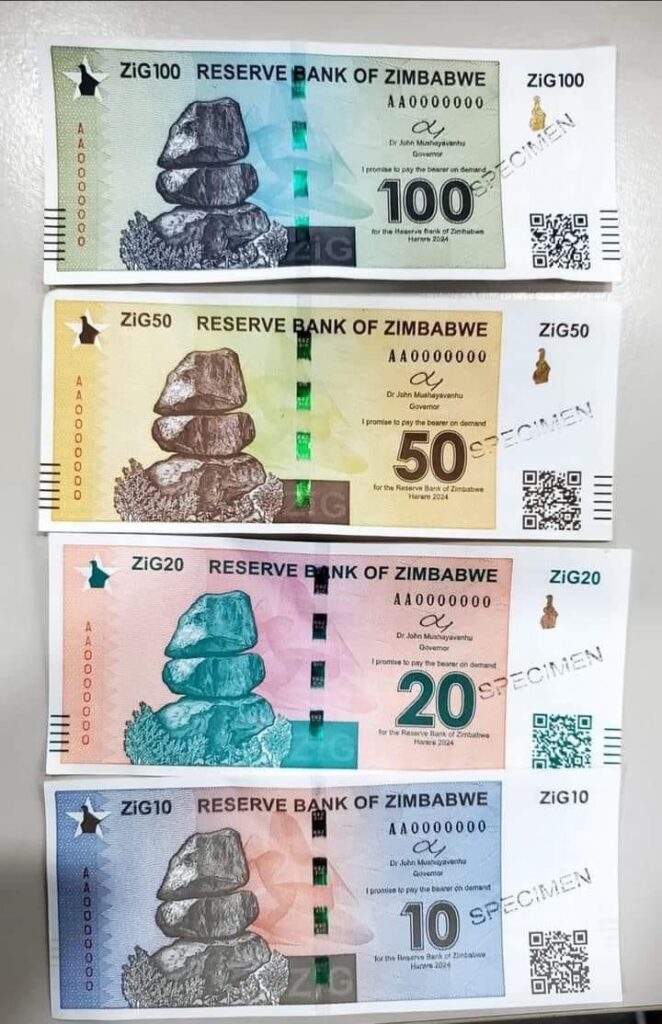RBZ Governor Introduces New Currency Zimbabwe Gold (ZiG)

by Privilege Zviregei
In a bid to address exchange rate volatility, curtail inflation, and restore macro-economic stability, Reserve Bank of Zimbabwe (RBZ) Governor, Dr John Mushayavanhu, unveiled the country’s new medium of exchange, the Zimbabwe Gold (ZiG).
The introduction of ZiG is part of several policy measures presented in the Monetary Policy Statement (MPS) aimed at recalibrating the monetary policy framework.
Dr Mushayavanhu emphasized that the new policy framework aims to restore price and exchange rate stability while remonetizing the local currency to serve as a medium of exchange and a store of value. The Governor stressed the importance of rebuilding market confidence, trust, and policy credibility to achieve these goals.
Exchange rate and inflation volatilities have been major challenges faced by the Zimbabwean economy, posing a threat to the local currency under the multi-currency system.
To tackle these issues, the RBZ proposed a range of new measures, including the introduction of a structured currency. Dr Mushayavanhu defined the structured currency as one that is pegged to a specific exchange rate or currency basket and backed by a bundle of foreign exchange assets, potentially including gold.
“The Reserve Bank is introducing a structured currency, which is generally defined as a currency that is pegged to a specific exchange rate or currency basket and backed by a bundle of foreign exchange assets (potentially including gold),” said Dr Mushayavanhu.
He further explained that the structured currency being introduced, ZiG, is anchored by a composite basket of currency and precious metals, primarily gold, held as reserves by the central bank.
The Governor identified high demand for foreign currency as a store of value, reduced confidence due to currency volatility, widening exchange rate disparities, reduced use of the local currency for domestic transactions, and lack of exchange rate predictability as factors contributing to exchange rate volatility and rapid inflation increase.
Dr Mushayavanhu acknowledged that the domestic economy had been moving towards full dollarization, with over 80 percent of market transactions conducted in US dollars. He cited public concerns over excessive bank charges, lack of change, rejection of soiled US dollar notes, and inconvenience caused by small denominations of the Zimbabwe dollar as reasons for the ineffectiveness of the local currency.
To foster simplicity, certainty, and predictability in monetary and financial affairs, the Zimbabwe dollar will be replaced by the Zimbabwe Gold (ZiG) at a starting exchange rate of 13,5686 ZiG to the US dollar.
The conversion of Zimbabwe dollar balances into ZiG will be facilitated by banks, and the new currency will co-circulate with other foreign currencies in the economy.
The RBZ issued Statutory Instrument 60 of 2024 to give legal effect to the currency changes, amending The Reserve Bank of Zimbabwe Act. Dr Mushayavanhu also mentioned that Statutory Instrument 218 of 2023 restored the use of multicurrency until December 31, 2030.
The central bank will prepare a roadmap to gradually promote the increased use of the new local currency as the nation progresses towards 2030.
The introduction of the structured currency, ZiG, backed by gold and foreign currency reserves, along with other policy measures, aims to achieve a solid and stable national currency, a stable and sustainable exchange rate, robust policy credibility, and the restoration of market confidence. The RBZ will implement the new policy framework sequentially to ensure lasting stability and predictability in financial, monetary, currency, and exchange rate matters.









